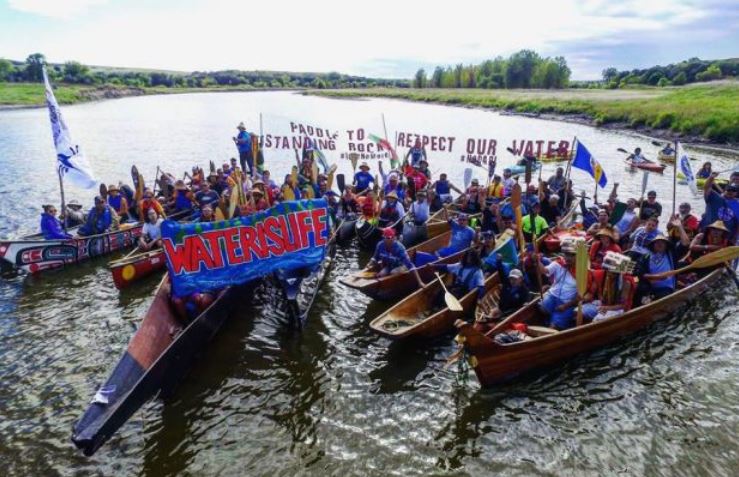They call themselves Protectors, not Protestors. They are the Dakota Sioux, standing together with over 200 tribes and 1100 tribal members, putting their bodies on the line at Sioux Standing Red Rock Reservation near Bismarck, North Dakota. In this unprecedented show of unity, they are defending their right to clean water as much as the preservation of their culture, against the Dakota Access pipeline. It is the largest gathering of Native Americans in almost 150 years.
The main adversary is the US government, specifically the U.S. Army Corps of Engineers, which approved the shortcut for the pipeline underneath the Missouri to deliver crude oil from North Dakota to Illinois and points further south. Fortunately for now, based on pushback from the Sioux Nation and independent media, the Army Corps has asked Dakota Access to voluntarily not construct 20 miles east and west, land bordering or under Lake Oahe until it can reevaluate its permits.
History:
The Dakota Access pipeline is the same length as the more famous the Keystone XL Pipeline. Originally slated to cross the Missouri near Bismarck, officials worried that an oil spill there would contaminate the state capital’s drinking water. So they moved the crossing to within a half a mile of the reservation, across land that was taken from the tribe in 1958, without their consent. If they’d communicated with the tribe—they would have learned that building the pipeline there would require digging up sacred spots and old burial grounds.
“Construction of the pipeline … and building and burying the pipeline, would destroy burial grounds, sacred sites, and historically significant areas on either side of Lake Oahe,” – complaint filed by Dakota Sioux.
Native Americans have withstood persecution for centuries from their primary adversary, the US government. The Red Rock Reservation is the site where the Sioux were once told to live when their lands were taken by the government in the 1860s. The reservation continued to shrink until the 1950s and early sixties when the same Army Corps of Engineers built five large dams along the Missouri, forcing Indian villages there to relocate. More than two hundred thousand acres disappeared under the water.
Water is life. And the Sioux believe humans are caretakers of the Earth. They stand in peace and prayer for everyone on the planet, a planet whose own health is essential for our mutual survival. The Sioux show a need for us to rediscover our sovereignty and free will through this experiment, or we, as a people, face an uncertain future. By their united front, they speak for the Earth to say that the well is running dry. Water is the basis for all life, making up 70% of us our bodies by weight and 70% of the planet by geography. It is in the air we breathe. It holds memory. It has consciousness. When the structure of water is affected, so is the collective consciousness.
“I am 80 years old. I’ve been jailed, I’ve been shot. This is the most beautiful thing I have ever seen. This is what I fought for.” – Clyde Bellecourt is one of the founders of the American Indian Movement, a significant civil rights group in the 1960s and ’70s
Clean Water at Stake
What is not being disclosed is the extent of damage due to these pipelines. While attention to the Dakota pipeline is limited by the mainstream press, a major spill in Mayflower Arkansas required mass evacuations of residents from an underground Exxon pipeline. A recent Wall Street Journal review found 1,400 pipeline spills and accidents in the U.S. from 2010-2013. Four of every five pipeline accidents are discovered by local residents, not the companies that own the pipelines. Beyond damage to the environment, property, and health, pipeline explosions are not infrequent. Just last month in New Mexico there was a pipeline explosion that killed 10 campers including 5 children.
Timeline:
On Friday, September 2nd, the Dakota Sioux filed court papers challenging permits from the Army Corps of Engineers’ by identifying sacred burial sites that are directly in the path of the proposed pipeline that will travel through 50 counties in four states.
On Saturday, September 3rd, the Access Pipeline company used that information to bulldoze and destroy those sites, literally bulldozing their ancestors right out of the ground, as well as cultural artifacts. They also hired security forces to attack the indigenous demonstrators with dogs and pepper spray.
“It is clear that the pipeline company is trying to “provoke” the peaceful resisters “to violence.” Not to mention a flagrant disregard for the legal process.” – activist Linda Black Elk, married to a Cheyenne River Sioux Tribal member
 Late Sunday, September 4th, the Dakota Sioux filed for a temporary emergency restraining order to halt construction of the Pipeline which argues that the U.S. Army Corps of Engineers approved the project without their consent.
Late Sunday, September 4th, the Dakota Sioux filed for a temporary emergency restraining order to halt construction of the Pipeline which argues that the U.S. Army Corps of Engineers approved the project without their consent.
Thursday, September 8th, Sen. Bernie Sanders introduced an amendment to the Senate’s water infrastructure bill that would require the US Army Corps to complete a full Environmental Impact Statement on the pipeline’s Missouri River crossing before issuing the final easement. However, the digging has already begun and no action has yet been scheduled on the amendment.
Friday, September 9th, For now, the U.S. Justice Department steps in to halt the construction of the pipeline to protect a lake on the pipeline’s route after a federal judge denied the request earlier in the day.
Forces Working Against the Sioux Nation:
- President Obama: An article in the New Yorker said that a run across the country this summer was organized to deliver petitions to the White House, but they were not received by Obama, someone who said in 2014 that he would partner with them.
- Banks “Bank of America, HSBC, UBS, Goldman Sachs, Wells Fargo, JPMorgan Chase and other financial institutions have, combined, extended a $3.8 billion credit line to Energy Transfer Partners, the parent company of Dakota Access.” Canadian-owned TD Bank to the north is contributing $365 million.
- Crowded Conditions in the Camp – “We know this place can’t handle many more people,” he said, standing in the Sacred Stone Camp. “Resources are stretched. Our community does not have a lot of money.” – Pancho from Standing Rock Reservation
- National Guard is backing up local authorities against the Sioux Activists and a major road has been blocked by police that carries supplies back and forth from the camps. Yet even with obstacles, there is a strong independent media presence, and Amnesty International is there investigating whether native American rights are being infringed upon.
The Opportunities:
The Sioux Nation stand-off offers several potentially positive things to all nations:
- There are now over 100 solidarity actions planned around the world thanks to pressure from the people.
- The “hacktivist” group Anonymous has decided to take a stand with the Native American protesters at Standing Rock, against the Dakota Access Pipeline.
- Social media is the driving force behind the growth of the protest. Govinda Dalton runs Spirit Resistance Radio 87.9 out of his white van. Social media led by hashtags like #waterislife, #NoDakotaAccess and #nodapl. Instagram and Facebook have been the most popular mediums, but Twitter is also being used.
- While petitions do not work, people can participate in lending support through crowdfunding. Go fund me!
- The Dakota Tribes show how each of us can step up, use our voices, and speak out against the injustices for our mutual survival and be noticed.
 Unzip the Sheepskin
Unzip the Sheepskin
This is a spiritual battle, an external battle that reflects the internal battle within each of us. Although the Justice Department has stepped in to grant a stay for the construction, the battle is not over. Nefarious forces will continue attempts to stamp out a culture and heritage that respects nature and inherent rights to water. This is not just about the plight of tribal nations. It is the plight of the human nation. The healing journey to protect the Earth is about our own survival as Earthlings. It up to each of us to follow the example of the Sioux, using peaceful means. No weapons are necessary. It’s time to unzip our sheepskin suits, and reveal the power of the wolf within wherever suppression finds us.
Rosanne Lindsay is a board certified Naturopathic doctor, a tribal healthcare provider under the Turtle Island Provider Network, Earth Keeper, liberty-lover, writer, and author of the book The Nature of Healing, Heal the Body, Heal the Planet. Find her on Facebook at Natureofhealing and her website at natureofhealing.org., where this article first appeared.


The halt on pipeline is only for one “sensitive area” while the rest of pipeline is allowed to be built.
It appears the route is still there. So it may be a head fake. By waiting, they defuse.
Exactly so. They are buckling under the pressure of social media and live videos from the site. They can no longer control the new independent media. All they can do is arrest those real journalists who are reporting on the truth (i.e., Amy Goodman who videoed the attacks of dogs and pepper spray on peaceful protectors.). Their tactics are backfiring. So while this may be a temporary reprieve, more people are noticing and standing up. That is necessary for pushback on a corrupt government.